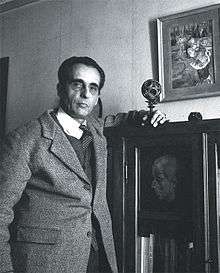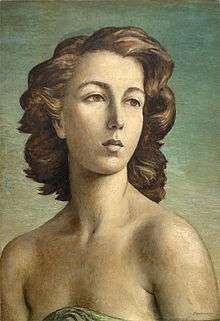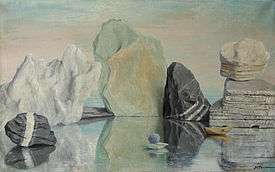Jean-Claude Fourneau
| Jean-Claude Fourneau | |
|---|---|
 | |
| Born |
28 March 1907 Paris (France) |
| Died |
9 October 1981 (aged 74) Paris (France) |
| Nationality | French |
| Known for | Painting, drawing |
| Notable work |
Portraits of: Felix Yusupov, Général Catroux, Jean Paulhan, Dominique Aury, Anne-Aymone Giscard d'Estaing, etc. |
| Movement | Surrealism |
| Website | jcfourneau.com |
Jean-Claude Fourneau (28 March 1907 – 9 October 1981) was a French painter close to the surrealist movement.
His mother was a descendant of Victor de Lanneau, restorer of the Collège Sainte-Barbe in Paris, of Juliette Adam, founder of a French paper, La Nouvelle Revue, muse of Léon Gambetta and the spiritual mother of Pierre Loti; and she was the daughter of Paul Segond, pioneer in the field of surgical gynaecology.
His father, Ernest Fourneau, was the founder of French medicinal chemistry.
Biography
Draughtsman and painter imbued with classicism and surrealism,[1] Jean-Claude Fourneau is first noticed at his show at the Jeanne Castel Gallery by André Salmon in 1932.[2] He continued exhibiting there until 1948.
Claude Roger-Marx sees his use of drawing as a medium and appreciates their detail: "The detail in Jean-Claude Fourneau's drawings gives us a sense of the infinite (...) Fascinating in the power and sensitivity that every stroke of his brush conveys."[3] For the literary character of his work, the critic quotes the artist himself: "I cannot conceive of a man painting who has no culture. I do not distinguish between painting and poetry, they both strive towards the same goal."[4]
Fourneau then specialises in portraits[5] and builds himself a solid reputation. Oriane de La Panouse, the countess of Paris, the Harcourt, Brantes, Faucigny-Lucinge, Seillière, Broglie, Pourtalès, Maillé, Montesquiou, Wendel families figure amongst his clients.
An intimate circle of people support his work leading François Pluchart to state in the review Combat during the André Weil Gallery show in 1963: "The Parisian fashion and intellectual circle has found its painter".[6] During the year of 1961, he interprets the role of the bishop Cauchon in Robert Bresson's The Trial of Joan of Arc.[7]
A show in Casablanca in 1954, made him known in Morocco where he lived for several years. He painted the portraits of Lalla Malika, the sister of King Hassan II, of Lalla Lamia, his step sister, of Karim Lamrani, his prime minister, of General Oufkir and other members of the Moroccan Royal Court. Claude Rivière states that Fourneau is the opposite of being a fashionable painter: "A great admirer of Antonin Artaud, of Paulhan, of Aragon, the artist calls upon his understanding of his model and goes beyond just a formal expression to impose his point of view." [8] Jean Paulhan asks himself: "By what secret, Jean-Claude Fourneau possesses such prolific fierceness?".[9]
Jean-Claude Fourneau appears on a photograph of surrealist artists gathered at the Café Cyrano in 1953,[10] and André Breton mentions him as being part of the group.[11] André Breton was a form of tutor to Fourneau, for whom he had a lot of affection and confirmed the influence of surrealism in its literary and artistic form in his work.
Fourneau wrote to André Breton at his address, rue Fontaine, in 1954 to try to temper the case of Story of O, of which he was a fervent defender, with the representation of the subliminal woman in Arcane 17 , an essay by Breton.[12] As if 'untempered love', 'elected love' could not find any better unravelling as in the paradox of opposites, pleasure against pain, violence against tenderness, free adult relations against faithfulness, strength against weakness...
On his return to Paris in 1968, Jean-Claude Fourneau pursues portrait painting and his last exhibition is held in 1976.
Work

- Portrait of Andrée Seillière,[13] oil on canvas, 1942 (coll. Andrée Jaigu)
- Portrait of Josée de Chambrun,[14] oil on canvas, 1947 (coll. Josée and René de Chambrun Foundation)
- Portrait of Felix Yusupov, oil on canvas, 1951 (coll. Fourneau)
- Portrait of Agnès Bourgois, oil on plywood, 1953 (coll. Fondation Agnès Troublé, dite agnès b.)
- Portrait of Général Catroux, oil on canvas, 1955 (coll. Maison d'éducation de la Légion d'honneur, Saint-Denis)
- Portrait of Céleste Albaret,[15] oil on canvas, 1957 (coll. Fourneau)
- Portrait of Princess Lalla Malika of Morocco, oil on canvas, 1958 (coll. Royal Palace of Rabat)
- Portrait of Jeanne-Marie de Broglie,[16] oil on canvas, 1958 (coll. J.-M. de Broglie)
- Portrait of Jean Paulhan, oil on plywood, 1964 (coll. Jacqueline Paulhan)[17]
- Portrait of Dominique Aury, oil on Isorel, 1965 (coll. Fourneau)
- Portrait of Diane de France, oil on plywood (coll. Diane de Würtemberg)
- Portrait of Karl de Würtemberg, oil on canvas (coll. Karl de Würtemberg)
- Portrait of Anne-Aymone Giscard d’Estaing, oil on canvas, 1969 (coll. A.-A. Giscard d’Estaing)
External links

- Jean-Claude Fourneau.
- « Notes et Carnets de Jean-Claude Fourneau », Ironie, n° 142, November 2009.
Notes and references
- ↑ André Breton, « Flair - Chronologie du surréalisme 1916 - 1953 », vignette 120; « Letters to Marcel Duchamp », vignette 10.
- ↑ André Salmon, Gringoire, June 1932: "It is necessary much to wait of the painter Jean-Claude Fourneau, a true young person, who has just made a noticed exposure at Jeanne Castel. Fourneau takes part of what one named, 15 years ago, the "organized naturalism". However his lyricism is new and personal. It releases from his works a radiant pleasure which must remain the essential power of this artist, when he comes to the period of constructive anguishes."
- ↑ Claude Roger-Marx, « Jean-Claude Fourneau », Arts et métiers graphiques, n° 35, May 1933.
- ↑ Claude Roger-Marx, ibid.
- ↑ "Once more, an ex-surrealist on examination: Jean-Claude Fourneau. Here the tone becomes society man and polished. The son of a great pharmaceutical dynasty, when he joined before the war the so badly judged group of accursed poets, undoubtedly did not imagine that his experiment would bring him to these portraits of princesses, countesses, marchionesses of Tout-Paris, beautiful and worry in their deserted corridors, in search of a heart, of a need, of a dream. Jean-Claude Fourneau succeeds Christian Bérard with his own style. It was not so easy and it is successful." Jean Bouret, « 7 jours avec la peinture », Les Lettres françaises, n° 1003, 14 Nov. 1963.
- ↑ François Pluchart, « Le Tout-Paris a trouvé son peintre : Fourneau », Combat, 6 Nov. 1963.
- ↑ "Procès de Jeanne d'Arc". Films de France. Retrieved August 8, 2015.
- ↑ Claude Rivière, « Jean-Claude Fourneau peintre de la vie moderne », Combat, 14 Nov. 1963.
- ↑ « L'actualité artistique », Le Figaro littéraire, 14 Nov. 1963.
- ↑ André Breton 42, Rue Fontaine, catalogue of the Calmels Cohen sale, Hôtel Drouot, April 2003, p. 193.
- ↑ Ibid. On the back of this photograph, as the legend of the catalogue specifies, Breton wrote the names of the group members, among which that of J.-C. Fourneau.
- ↑ Bibliothèque Jacques Doucet, 2 lettres de Jean-Claude Fourneau à André Breton, Paris, 9 décembre 1954 ; 12 février 1955.
- ↑ Sister of Ernest-Antoine Seillière.
- ↑ Daughter of Pierre Laval and wife of René de Chambrun.
- ↑ Servant of Marcel Proust.
- ↑ Member of Conseil d'administration du musée d'Orsay, Member of Conseil d'administration de la Société des amis du Louvre, former manager of Christie's-Europe, donor to French Musées nationaux.
- ↑ Cf. Bulletin de la Société des lecteurs de Jean Paulhan, n° 30, Oct. 2007, p. 17.